Malaria is one of the life-threatening infectious diseases whose impacts are experienced in the global healthcare systems. It is known to cause deaths in both endemic and non-endemic regions. Ordinarily, malaria disease I found predominantly within the tropical and subtropical regions where climatic conditions favor survival and transmission of the parasite. Some of the regions where malaria occur are Sub-Saharan Africa, Latin America and southern Asia.
In regard to the impact of malaria, the disease causes enormous disease burden to the global population. Globally, more than 200 million cases are reported every year. Epidemiological reports indicate that 3.3 billion people from 106 countries and territories experience a high risk of malaria transmission. However, the greatest burden of malaria disease occurs in the African region. In 2010, this region accounted for 91% of the global malaria deaths, whereas South-east Asian region and Eastern Mediterranean region recorded 6% and 3% of deaths, respectively.
However, it is worth noting that, malaria causes a significant percentage of deaths in non-endemic areas. For instance, in the US, its prevalence reached the highest level in 2011 since 1971. However, most U.S. residents acquired the disease from tropical countries where it is endemic. Epidemiological reports indicate that 70% of malaria cases in 2011were acquired from tropical countries, primarily in Africa.
Table of Contents
- Introduction
- Malaria Parasite and Transmission
- Hallmark Clinical Presentation Features
- Treatment
- Prevention and Control Measures
Objectives and Key Themes
This text provides a comprehensive overview of malaria, a life-threatening infectious disease with a significant global impact. The text delves into the parasite's transmission, clinical manifestations, treatment options, and prevention strategies.
- The epidemiology and burden of malaria disease
- The biology and transmission of the malaria parasite
- The clinical features and diagnosis of malaria
- Treatment options and challenges for malaria
- Prevention and control strategies for reducing malaria transmission
Chapter Summaries
- Introduction: This chapter provides a general overview of malaria, outlining its global impact, prevalence in various regions, and the burden it places on global healthcare systems.
- Malaria Parasite and Transmission: This chapter focuses on the causative agent of malaria, the Plasmodium parasite, and its transmission via infected Anopheles mosquitoes. It describes the parasite's life cycle and the factors that influence transmission, including climate and human immunity.
- Hallmark Clinical Presentation Features: This chapter explores the typical clinical signs and symptoms of malaria, including fever, headache, and vomiting. It also discusses the different stages of the parasite's life cycle and their respective clinical manifestations.
- Treatment: This chapter examines the various treatment options available for malaria, including antimalarial drugs and blood transfusions. It highlights the importance of early detection and the challenges of treating severe malaria, such as cerebral malaria.
- Prevention and Control Measures: This chapter outlines various prevention and control strategies, emphasizing the importance of long-lasting insecticidal nets (LLINs), insecticide-treated nets (ITNs), and indoor residual spraying. It also discusses the ongoing research efforts to develop vaccines and genetically modified mosquitoes to combat malaria.
Keywords
This text focuses on malaria, a parasitic disease with significant global health implications. Key themes include parasite transmission, clinical manifestations, treatment options, and prevention strategies. Other important concepts include Plasmodium species, Anopheles mosquitoes, drug resistance, and the impact of malaria on human health.
- Quote paper
- Patrick Kimuyu (Author), 2018, The Epidemiology of Malaria Disease, Munich, GRIN Verlag, https://www.grin.com/document/431373




